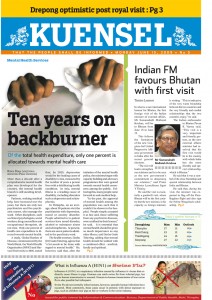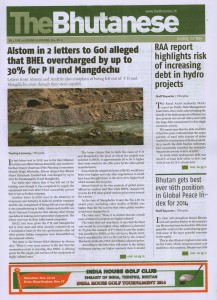At the very beginning, the government created Kuensel. Then the government said, let there be liberalization, and there was, Bhutan Times and Bhutan Observer – two years prior to Bhutan’s democratic transition.

And then the government said, let there be many more, and there was, in chronological order, Bhutan Today, Business Bhutan, The Journalist, Druk Neytshuel, with a couple of magazines thrown in as well. Six newspapers in a span of a few years. Seven publications, again, not including the magazines, for a population that mostly watches television or listens to the radio for its news.
Is this an indication of a healthy and vibrant newspaper scenario in Bhutan? Not quite. The entrance of Bhutan Times and Bhutan Observer in 2006, ended the 20-year monopoly of ‘informing the nation’ by the national newspaper Kuensel. At that time, journalists at the national newspaper felt the advent of private newspapers was the best thing that could happen to Kuensel.
And, why not, competition had been created.
Editors at Bhutan Times when it was launched, promised a “true people’s paper, with emphasis on youth”, while people manning Bhutan Observer talked of a newspaper that would focus on in-depth stories of rural Bhutan. In 2007, the country’s first daily, Bhutan Today, was launched. The proprietor of the daily said his paper would provide a “new perspective”. He hoped that within three months of the daily’s launching, the newspaper would have reporters in all 20 dzongkhags.

While the existence of three more papers in the market caused Kuensel to sit up, initial promises gradually faded. Neither did Bhutan Times become a true people’s paper, if that meant brave reporting, nor did Bhutan Observer represent the rural masses adequately. Bhutan Today did not provide any new perspective. It never got 20 reporters in 20 dzongkhags. All four newspapers somewhat became carbon copies of each other. This was, perhaps, to be expected, with most of the journalists being former Kuensel reporters and editors. But the private newspapers were also experiencing the financial pinch in maintaining bureaus outside Thimphu, and realizing the lack of interest among readers for rural stories. Story coverage slowly converged onto Thimphu.
In fact, readers even began complaining against the poor grammar of newspapers. Pages reserved just for skimpily clad Hollywood celebrities and gossip also caused many news buffs to dismiss the newspapers, for its quality content.
Despite all that, Bhutan Today had one very big impact as a daily. It caused Kuensel to respond. Kuensel management instructed its understaffed and rather young editorial team to prepare to go daily. Kuensel at that time was following a bi-weekly schedule.
It was also around this time that a new style of reporting was causing readers to pay more attention to the fourth estate: investigative journalism. This began attracting a following with stories that pushed boundaries that had not been probed before by young reporters just foraying into the Bhutanese journalism scene.
This was a style of reporting that was exciting for readers to read, and allowed the byline to receive some attention. Others, realizing the risks of such reporting in a small society, kept away, or practiced a subtler form of it.
Another phenomenon occurring around this time included the newspapers being regularly chastised for being too critical, especially of the government. This was because the government was mostly at the receiving end of critical reports. The more controversial a report, the more likely it was to be displayed on a newspaper’s front page or cover. While newspapers admitted that they needed to be more careful in what they displayed on their covers, they did not agree with the government on the being too critical argument.
Even Kuensel, long accused of being the government mouth piece, replied in one of its editorials: “In the past, we said a bridge has been inaugurated, today we are saying that the bridge has been inaugurated but it has overstepped its budget and deadline. Is there anything wrong with that?” Nothing at all. Government officials would simply have to become accustomed to this new environment of accountability and transparency. Also people were bored reading about workshops and seminars. People wanted to read about corruption, scandals, and see authority questioned.
In 2009, the government introduced the annual journalism awards. It was not without controversy and had to be scraped off. Today, there is no platform or forum to recognize journalists in Bhutan for their work and labor.
That same year – 2009, a fifth newspaper was established: Business Bhutan. Unlike earlier newspapers, this weekly sought to provide simplified business news. Its management said they were confident of finding space in an already crowded sector.
But not all was well. A sixth newspaper was in the works. Bhutan Times declared a loss of Nu 5.4 million. A management change later, 12 reporters, including its editor, claiming editorial interference, resigned en masse. The incident marked the first major conflict between journalists and their owners, and perhaps in some way was a healthy sign of that journalists took their editorial independence seriously. But it was also an indication that the nascent newspaper industry was growing faster than the pool of professional journalists and managers were.
The resigning journalists would go on to form The Journalist, a weekly. The Journalist began with a bang, but like most things in Bhutan that start full of enthusiasm, would almost fold a year later. It has nevertheless carried on. A year later, another newspaper – The Bhutanese was launched.

To reiterate, seven newspapers for a population that mostly watches television for its news. How do they survive? The government indirectly finances their survival through advertising. It’s an advertising industry worth more than Nu 300 million.
So it wasn’t with surprise when some of the newspapers, as pointed out in their editorials and news reports, expressed disappointment when the government announced the circulation audit. They said such a move to gauge their circulation and reach, and thus determine the amount of government advertisements they will get, threatens their very survival while giving the national newspaper the advantage to acquire more money based on its already existing infrastructure. Such a stance reflects badly on newspapers. The government is in fact talking about making an inefficient system of expenditure, well, efficient. It is after all, tax payer money that they’re talking about. Citizens don’t want to see their money wasted on seven newspapers that are almost practically a carbon copy of each other. It is a fact that the same Thimphu centric stories can be read in simply different styles.
A newspaper is not started for government handouts. A newspaper is started as a responsibility to society. According to media reports, that’s what Bhutanese newspaper owners or editors said at the birth of their watch dogs. You start a business, in this case, a newspaper with an understanding of the risks and challenges in the existing market, and you find ways to overcome these challenges by offering something different, by being innovative.
Even if the government does not implement a more efficient advertising policy, does this guarantee the survivability of all newspapers? With most of the newspapers not really offering anything new, and with talks of more local television channels on the way, market forces will eventually eliminate the non-innovative newspapers.The government may have said, let there be many newspapers, allowing this brief creationism period, but the newspapers should have been aware that evolution and natural selection also apply.
In the end, those who adapt best to the market situation will survive. There are already newer forms of journalism emerging in the young Bhutanese media.

